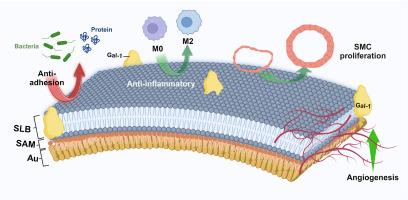Versatile effects of galectin-1 protein-containing lipid bilayer coating for cardiovascular applications
Abstract
Modulating inflammatory cells in an implantation site leads to severe complications and still unsolved challenges for blood-contacting medical devices. Inspired by the role of galectin-1 (Gal-1) in selective functions on multiple cells and immunomodulatory processes, we prepared a biologically target-specific surface coated with the lipid bilayer containing Gal-1 (Gal-1-SLB) and investigate the proof of the biological effects. First, lipoamido-dPEG-acid was deposited on a gold-coated substrate to form a self-assembled monolayer and then conjugated dioleoylphosphatidylethanolamine (DOPE) onto that to produce a lower leaflet of the supported lipid bilayer (SLB) before fusing membrane-derived vesicles extracted from B16-F10 cells. The Gal-1-SLB showed the expected anti-fouling activity by revealing the resistance to protein adsorption and bacterial adhesion. In vitro studies showed that the Gal-1-SLB can promote endothelial function and inhibit smooth muscle cell proliferation. Moreover, Gal-1- SLB presents potential function for endothelial cell migration and angiogenic activities. In vitro macrophage culture studies showed that the Gal-1-SLB attenuated the LPS-induced inflammation and the production of macrophage-secreted inflammatory cytokines. Finally, the implanted Gal-1-SLB reduced the infiltration of immune cells at the tissue-implant interface and increased markers for M2 polarization and blood vessel formation in vivo. This straightforward surface coating with Gal-1 can be a useful strategy for modulating the vascular and immune cells around a blood-contacting device.


 求助内容:
求助内容: 应助结果提醒方式:
应助结果提醒方式:


